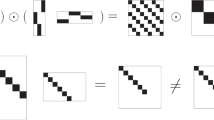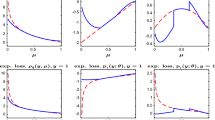Abstract
Constructing a good approximation to a function of many variables suffers from the “curse of dimensionality”. Namely, functions on ℝN with smoothness of order s can in general be captured with accuracy at most O(n −s/N) using linear spaces or nonlinear manifolds of dimension n. If N is large and s is not, then n has to be chosen inordinately large for good accuracy. The large value of N often precludes reasonable numerical procedures. On the other hand, there is the common belief that real world problems in high dimensions have as their solution, functions which are more amenable to numerical recovery. This has led to the introduction of models for these functions that do not depend on smoothness alone but also involve some form of variable reduction. In these models it is assumed that, although the function depends on N variables, only a small number of them are significant. Another variant of this principle is that the function lives on a low dimensional manifold. Since the dominant variables (respectively the manifold) are unknown, this leads to new problems of how to organize point queries to capture such functions. The present paper studies where to query the values of a ridge function f(x)=g(a⋅x) when both a∈ℝN and g∈C[0,1] are unknown. We establish estimates on how well f can be approximated using these point queries under the assumptions that g∈C s[0,1]. We also study the role of sparsity or compressibility of a in such query problems.
Similar content being viewed by others
Notes
We use the following conventions for constants. Absolute constants are denoted by c 0 (when they appear in bounds that hold for sufficiently small constants) or C 0 when they appear in bounds that hold for sufficiently large constants. The constants are updated each time a new condition is imposed on them. Since there will be a finite number of updates, the final update will determine its value. Constants that are not absolute but depend on parameters will be denoted by C, and the parameters will be given. We use the same convention on updating the constants C.
References
Baraniuk, R., Davenport, M., DeVore, R., Wakin, M.: A simple proof of the restricted isometry property for random matrices. Constr. Approx. 28, 253–263 (2008)
Belkin, M., Niyogi, P.: Laplacian eigenmaps for dimensionality reduction and data representation. Neural Comput. 15, 1373–1396 (2003)
Candès, E., Romberg, J., Tao, T.: Stable signal recovery from incomplete and inaccurate measurements. Commun. Pure Appl. Math. 59, 1207–1223 (2006)
Chi, Z.: On ℓ 1-regularized estimation for nonlinear models that have sparse underlying linear structures. ArXiv e-prints, Nov. (2009)
Cohen, A., Dahmen, W., DeVore, R.: Compressed sensing and best k term approximation. J. Am. Math. Soc. 22, 211–231 (2009)
Cohen, A., DeVore, R., Schwab, C.: Convergence rates of best n term Galerkin approximations for a class of elliptic SPDEs. Found. Comput. Math. 10(6), 615–646 (2010)
Coifman, R., Maggioni, M.: Diffusion wavelets. Appl. Comput. Harmon. Anal. 21(1), 53–94 (2006)
DeVore, R.: Nonlinear approximation. Acta Numer. 7, 51–150 (1998)
DeVore, R., Lorentz, G.G.: Constructive Approximation. Grundlehren der mathematischen Wissenschaften, vol. 303. Springer, New York (1993)
DeVore, R., Petrova, G., Wojtaszczyk, P.: Instance optimality in probability with an ℓ 1-minimization decoder. Appl. Comput. Harmon. Anal. 27, 275–288 (2009)
DeVore, D., Petrova, G., Wojtaszczyk, P.: Approximating functions of few variables in high dimensions. Constr. Approx. 33, 125–143 (2011)
Foucart, S., Pajor, A., Rauhut, H., Ullrich, T.: The Gelfand widths of ℓ p balls for 0<p≤1. Preprint
Gaiffas, S., Lecue, G.: Optimal rates and adaptation in the single-index model using aggregation. Electron. J. Stat. 1, 538 (2007)
Golubev, G.K.: Asymptotically minimax estimation of a regression function in an additive model. Probl. Pereda. Inf. 28, 101–112 (1992)
Haupt, J., Castro, R., Nowak, R.: Distilled sensing: Adaptive sampling for sparse detection and estimation. Preprint (2010)
Juditsky, A., Lepski, O., Tsybakov, A.: Nonparametric estimation of composite functions. Ann. Stat. 37(3), 1360–1404 (2009)
Li, K.-C.: Sliced inverse regression for dimension reduction. J. Am. Stat. Assoc. 86(414), 316–327 (1991)
Lorentz, G.G., Von Golitschek, M., Makovoz, Y.: Constructive Approximation—Advances Problems. Grundlehren der mathematischen Wissenschaften, vol. 304. Springer, New York (1996)
Maathuis, M.H., Kalisch, M., Buhlmann, P.: Estimating high-dimensional intervention effects from observational data. Ann. Stat. 37, 3133–3164 (2009)
Stone, C.J.: Additive regression and other nonparametric models. Ann. Stat. 13, 689–705 (1985)
Traub, J., Wozniakowski, H.: A General Theory of Optimal Algorithms. Academic Press, New York (1980)
Traub, J., Wassilkowski, G., Wozniakowski, H.: Information-Based Complexity. Academic Press, New York (1988)
Wainwright, M.J.: Information-theoretic limits on sparsity recovery in the high-dimensional and noisy setting. IEEE Trans. Inf. Theory 55, 5728–5741 (2009)
Acknowledgements
This research was supported by the Office of Naval Research Contracts ONR-N00014-08-1-1113, ONR N00014-09-1-0107; the AFOSR Contract FA95500910500; the ARO/DoD Contract W911NF-07-1-0185; the NSF Grant DMS 0915231; the French-German PROCOPE contract 11418YB; the Agence Nationale de la Recherche (ANR) project ECHANGE (ANR-08-EMER-006); the excellence chair of the Fondation “Sciences Mathématiques de Paris” held by Ronald DeVore. This publication is based on work supported by Award No. KUS-C1-016-04, made by King Abdullah University of Science and Technology (KAUST).
Author information
Authors and Affiliations
Corresponding author
Additional information
Communicated by Wolfgang Dahmen.
Rights and permissions
About this article
Cite this article
Cohen, A., Daubechies, I., DeVore, R. et al. Capturing Ridge Functions in High Dimensions from Point Queries. Constr Approx 35, 225–243 (2012). https://doi.org/10.1007/s00365-011-9147-6
Received:
Revised:
Accepted:
Published:
Issue Date:
DOI: https://doi.org/10.1007/s00365-011-9147-6




